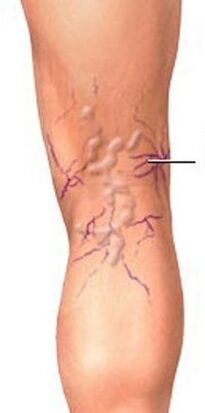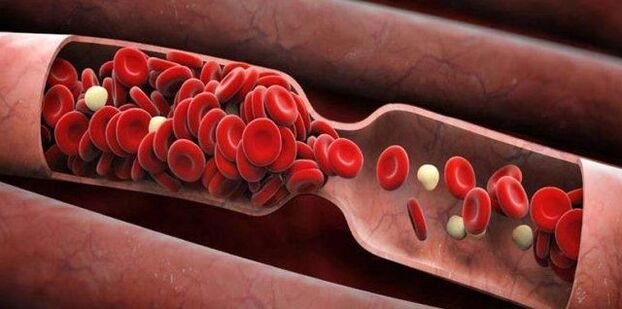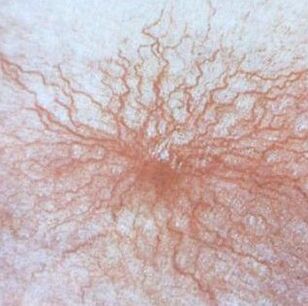Varicose veins are a pathological process that is characterized by an increase in the lumen of blood vessels that provide blood outflow, thinning of their walls and deformation up to the formation of nodes and ruptures. For anatomical reasons, the disease is most often found in the veins of the lower extremities.

The external signs of varicose veins are not an exceptionally aesthetic problem: vascular "stars", protruding a dark shade - only symptoms of blood circulation disorders, which are fraught with life -threatening consequences.
The mechanism of the development of varicose veins on the legs
The mechanism of development of varicose veins is associated with a decrease in the functionality of the venous valves. They are subject to large mechanical loads, therefore, under the influence of genetic factors, hormonal jumps, inflammations in the tissues of the lower extremities and loads, weaken and do not prevent the opposite flow of blood. Inflammation occurs against the background of stagnant phenomena associated with high viscosity of blood, hypodynamia or prolonged stay in a standing or sitting position.
The pressure of the excessive volume of blood on the walls of the veins deform them, depriving functionality of the muscle and nervous venous wall, which provide its stable tone. Stagnation of blood, outstanding of blood vessels and inflammation of their walls often lead to the formation of accumulations of blood cells, which overlap the lumen of the veins.
Varicose veins on the legs, therefore, is not a superficial problem associated with mechanical damage to the subcutaneous vessel or temporary phenomena, but a deeper circulatory disorders that developed in the patient’s prone to disease under the influence of risk factors.
Medication therapy of the disease is aimed at:
- Toning the walls of blood vessels;
- removal of inflammation;
- liquefaction of blood;
- Prevention of blood clots.
In the absence of adequate treatment, what is dangerous to varicose veins of the lower extremities can become reality for each of the patients with this disease.
In 80% of cases, women suffer from varicose veins on the legs. The main thing that is dangerous varicose veins in women is the likelihood of early development of the disease due to hormonal jumps during puberty or pregnancy. During the bearing of the fetus, only gentle therapy is possible that does not have the teratogenic effect. Additional leg burden, lack of intensive treatment and load during attempts can stimulate the aggravation of the disease.
What threatens varicose veins?
As a rule, thrombophlebitis and other dangerous consequences of varicose veins occur at the 3rd stage of venous insufficiency. Symptoms of late stages of vascular failure:
- constant severity in the legs;
- swelling;
- The darkening of the skin in the area of the ankles.

Dermatitis, eczema, and skin inflammation provoke violation of blood circulation in the limbs.
Telengiectasia is the least dangerous consequence of venous insufficiency. The condition is characterized by the appearance of vascular "nets" and "stars", which are accompanied by edema, fatigue of the legs, the regular occurrence of a feeling of numbness and night seizures in caviar. Aesthetic defect is one of the reasons why women often turn to Phlebologist in the early stages of varicose veins. In an effort to save the legs beautiful, patients care about their health.
Subcutaneous bleeding and gaps of veins
Thrombophlebitis - thrombosis against the background of inflammation of the venous wall and blood stagnation in an expanded vessel. The developed disease is characterized by the compaction and pain of palpation (probing) of the affected vessel, as well as redness of the skin around the thrombus. Thrombophlebitis develops about 25% of patients who have diagnosed varicose veins. Blood clots that are in the surface veins have a low hazard of separation with harm to health, however, in the case of promoting a blood clot along a subcutaneous or perforated vessel, immediate hospitalization is necessary.
Deep thrombosis is much more dangerous than varicose veins and thrombophlebitis. Blood clots formed in deep vessels of the lower extremities are capable of separation and clogging of the pulmonary artery, which leads to death. The characteristic symptoms of deep vein thrombosis are severe edema of the limb that occurs in a short time, and a sharp bursting pain in the calf or femoral muscle. The spread of the pathological process to deep vessels of the lower extremities can be observed in the later stages of varicose veins.
A trophic ulcer is a deep dermis defect that forms in the later stages due to impaired blood flow in the surface layers of the skin. It represents a long -healing painful wound, which is difficult to give in to therapy.
Varicosis of the veins of the lower extremities is one of the risk factors in the development of such a pathology in other vessels of the small pelvis of men and women.
Medical measures against the consequences of varicose veins
Treatment of complications of varicose veins on the legs, as a rule, begins with drug therapy for the primary disease.
To reduce the deformation of blood vessels, which expand due to a decrease in tone, Venotonic based on hesperidine, diosmine, Esculin, etc. are prescribed.

With inflammation of the venous walls, drugs are prescribed from the group of non -steroidal anti -inflammatory drugs in the form of tablets and gels. The oral reception of anti -inflammatory drugs is recommended for thrombophlebitis.
A decrease in blood viscosity is achieved using the local use of ointments with anticoagulant components and oral intake of routine and methylxanthin derivatives, which have antiagregantami properties.
The surface manifestations of varicose veins on the legs (including telangiectasia) are eliminated by sclerotherapy (gluing the walls of the affected vessel using a special drug). The procedure does not cause significant harm to health and does not violate the blood flow, becauseDuring rehabilitation, the function of surface veins cross deep vessels.
With deep vein thrombosis, bed rest is prescribed, intravenous administration of anticoagulants and anti -cargans with the control of blood viscosity. Surgical treatment for deep vessels thrombosis and thrombophlebitis (including large subcutaneous veins) is indicated if there is a high risk of blockage of the pulmonary artery. The treatment of trophic ulcers is aimed at stimulating the healing of the wound and the therapy of the primary disease.
Preventive measures
Prevention of varicose complications includes the following measures:
- wearing compression linen;
- physiotherapy physical education;
- exclusion of a long sitting and standing;
- the choice of shoes with a heel is from 2. 5 to 6 cm;
- enrichment of the diet with fiber and sources of vitamins B1, C, E and P;
- compliance with the water norm (2. 5 l);
- contrasting water procedures;
- rejection of hormonal contraceptives (the effect of COC on the female body includes increasing the risk of thrombosis);
- Folk methods (compresses, baths, etc. ).
Early diagnosis of varicose veins, timely adequate treatment and a decrease in the effect of risk factors prevents the development of complications of the disease. The use of minimally invasive surgical methods in some cases eliminates not only aesthetic problems, but also the probability of aggravation of the pathological process.


















